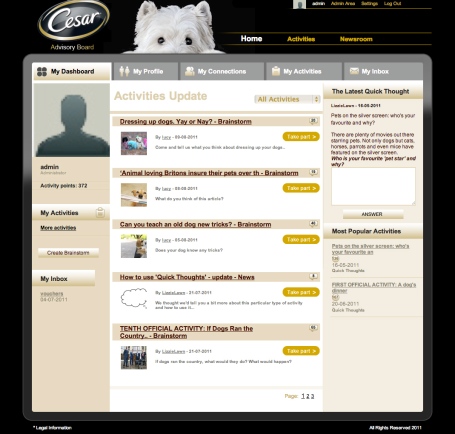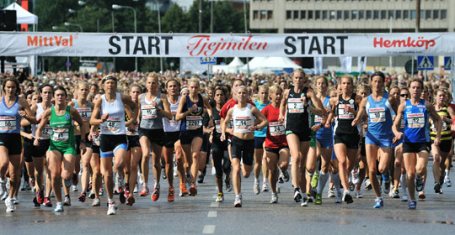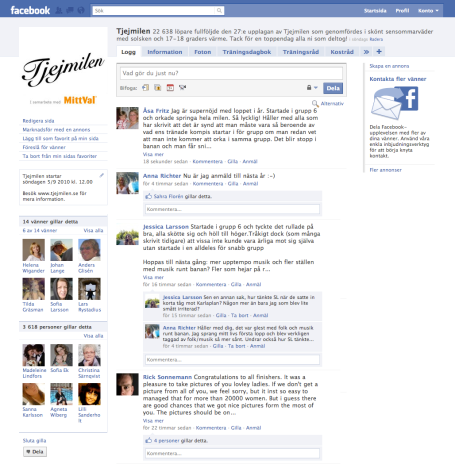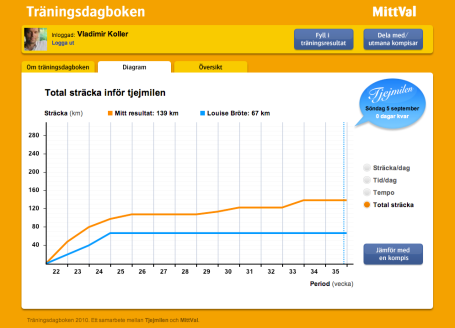Projektexempel – Cesar Advisory Board
Min roll i projektet
Jag hade en övergripande roll från första början och skapade en konceptprototyp som låg till grund för Cesars val av vår lösning. Som projektledare ansvarade jag även för alla kundkontakter med Cesar i England samt ledningen av det turkiska utvecklingsteamet. Efter projektstart arbetade jag med gränssnitt- och interaktionsdesign, där jag skapade en interaktiv wireframe som visade upp systemets funktionalitet. Utvecklingen av plattformen skedde i nära samarbete med kunden och min wireframe fungerade som en levande projektplan som ändrades under projektet gång. Min informationsdesign blev en grund för den grafiska designen som togs fram efter mina anvisningar. CAB lanserades i början på sommaren och min roll har övergått till testning och support i samband med att projektet närmar sig slutet. Till hösten planeras en utbyggnad av systemet med nya funktioner och verktyg.
Om Facebooks Edgerank formel
Många företag och privatpersoner vet ännu inte om att Facebook tar bort majoriteten av alla statusuppdateringar som skrivs av alla ens vänner och företagssidor man gillar. Detta görs för att vi ska främst nås av information som är relevant för oss. Facebooks värsta skräck är att vi lämnar plattformen eftersom vi översköljs av en massa ointressant skräp. Då ser vi inte heller alla annonser som Facebook publicerar och Facebook slutar tjäna pengar på vårt deltagande. Inte bra alls, därför har de skapat den s.k. Edgerank formeln, som räknar ut vilken information som är viktigast för varje användare och visar upp den.
Det är Edgerank som gör att vi inte ser statusuppdateringar från alla våra kompisar eller företagssidor vi är fans till, fast vi vet att de har skrivit något nyligen. Principen bakom detta är ganska enkel och följer helt Facebooks övriga filosofi. Fasta och långsiktiga band belönas mer än flyktiga och kortsiktiga.
Om man vill att ens kommunikation ska synas på andras loggar, ska man därför publicera innehåll med så hög kvalite som möjligt. Här värderar Facebook filmer och bilder högre än länkar, länkar högre än statusuppdateringar och sist kommer gillande av annat innehåll.
Facebook skiljer även om ens fans eller kompisar kommunicerar med mig på sitt eget loggflöde, eller om de faktiskt besöker min sida och skriver inlägg direkt på min logg. Detta är förstås ett tecken på större engagemang och premieras därför starkt av Facebook. Facebook belönar även tid som spenderas på andras sidor och dessutom mäter man även hur pass aktuellt information är.
Om man som företag vill se till att många av ens fans får läsa företagets statusuppdateringar, behöver man först lägga ut intressant innehåll, gärna filmer/bilder eller länkar som är intressant för fansen. Man vill även uppmana till interaktion med företaget, helst på den egna FB sidan. Det bästa är om man kan få fansen att skriva längre berättelser och kommentarer till bilder som laddas upp på företagets sida. Och se till att detta upprepas med jämna mellanrum.
Detta är en väldigt kortfattad beskrivning av hur Edgerank fungerar. Jag rekommenderar att läsa dessa två intressant artiklar som förklarar funktionaliteten i detalj. En detaljerad kunskap om Edgerank är ett måste, om man vill kunna optimera sin Facebookkommunikation.
När jag får tid, ska jag skriva ned lite fler tankar kring detta ämne.
Vladimir
A summary of Facebook´s new Pages
Intro
Facebook is updating Pages with new design and functionality. This major update will be made permanent on 11 of March, 2011. Here are some of the most important changes:
- The ability to like and post on other pages as your page
- Notifications when fans interact with your page or posts
- New Page navigation bar instead of tabs
- A place to showcase photos along the top of your page
- frames instead of FBML for custom made content
The best news for brands on Facebook is that they don´t have to try and pull customers away from Facebook to get them onto their site. There are now better options for accomplishing their sales or branding goals entirely within Facebook.
Read on for a more detailed explanation of the new Pages, together with some conclusions and suggested strategies.
Design & Interface
- The profile picture size for Pages has been adjusted from 200×600 to 180×540
- The Info Subpage have replaced the short info section below the profile picture
- Tabs have been removed and changed into navigation icons placed below the profile picture
- The Fan Count section in the left column have been simplified, with fan pics eliminated
- A Page can now like other Pages and promote five other Pages in the left column
- Pages can now display the page owners/admins
- The five most recent photos that you have published or tagged your Page in are displayed randomly at the top of your Page. Photos posted by fans will not appear here
- Wall posts can now be sorted by Brand only posts, Top Posts or Most recent posts
- The display of friends who like this Page section, have been moved to the top right corner
Design & Interface – Conclusions
The removal of tabs is a big change which will most likely upset and confuse some users. The upside is that removing the tabs clears up the main content area from conflicting design elements. Brands have now a empty area to play around with and with the new Iframe functionality, they can do pretty much what they want with it.
The new navigation menu shows eight icons in its default view. The icon order can be changed, except for Wall and Info. Once users are used to the new navigation, it will be a big improvement since it opens up the Page and makes it more flexible, while keeping the navigation simple and clean.
The randomization of the top images encourages frequent uploads of new images rather than using it for branding, since it´s impossible to know in which order the images will be viewed. Some companies have already found creative use for this functionality. Here is a example.
There is a new area below the navigation menu which displays five selected Pages that are liked by your Page (see more about this below). There is also a display of the Page admins, this information is optional, but it gives the Page a human face and is a very nice addition.
The removal of Film, Link and Video sections from the main interface, together with moving the “friends who likes this page” section to the top right corner, results in a cleaner interface. The consensus among most Facebook experts is that these changes are a big step forward.
It is also believed that with these changes, Facebook is attempting to bridge the gap between Pages and Websites, providing the same abilities as a site, but with the social perspective of Facebook.
Page Interaction
- 10 – You can now post on other Pages as your Page and view a newsfeed for your Page
- 11 – Page Admins can now receive notifications when people post or comment on their Page
- 12 – Page admin can now easily switch between his personal Profile and the Page identity.
- 13 – When people visit your Page, they will be able to view friends who also like your Page, as well as other Pages that both they and your Page like
Page Interaction – Conclusion
The possibility to interact as a Page means that your Brand can use Facebook in the same way as individuals. Pages can now like other Pages, comment on them and even tag themselves in images. This means more exposure to your brand, in the same way as liking other friends gives your personal Profile a greater exposure.This is both a opportunity and a threat. You can now post on other Pages as your brand, increasing exposure/awareness. However, other brands can also post on your Page. This could open the door for a new kind of spam from less scrupulous companies.
Functionality Changes
The Static FBML App, which has been the primary custom content creation tool is to be pulled on March 11, 2011. Static FBML Tabs will instead be replaced with Facebook Canvas Application subpages and Iframes.
The switch to iFrames means that developers can create dynamic web apps using their standard tools (HTML, CSS, PHP, ASP, JavaScript, Flash, etc.), register them as a Facebook “Canvas” app and then embed the app on a custom Page via the iFrame.
The good news for Static FBML users is that Facebook will continue to support existing installed applications and the custom tabs, as well as continue to allow admins to add and edit their custom tabs, even after March 11, 2011. However, they do urge people to migrate their custom tabs to iFrames sooner rather than later, as they are gradually eliminating FBML.
Creating Canvas Application subpages is slightly more complicated than creating new Static FBML tabs. The age of the amateur coder on Facebook may therefore be coming to a close. This is mainly a good thing since it will lead to better designed Pages and a more professional environment.
The Iframe opens up new possibilities since a Facebook Page can now do anything a normal web page can do. This is in line with Facebooks intention to bridge the gap between normal websites and Facebook.
You can also download this report as a PDF.
This post is based on information gathered from many sources, particulary these three fine articles:
http://www.socialmediaexaminer.com/8-new-facebook-page-changes-what-you-need-to-know/
http://www.hyperarts.com/blog/facebooks-new-fan-page-design-reduced-tab-width/
http://mashable.com/2011/02/24/facebook-pages-iframes/
Other Facebook Resources
http://www.allfacebook.com/
http://fbmhell.com/
Written and compiled by
Vladimir
One Hot Pixel designs a new FB Page for Street Art Festival
One Hot Pixel have created a new Facebook Page for the Festival of Alternative Arts, taking place in Amman, Jordan.
The Festival of Alternative Arts is organized by The Embassy of Sweden, in close cooperation with both Jordanian and international partners. The festival consist of lot of separate activities, exhibitions and happenings, all taking place in Amman from December 2010 to February 2011.
The “Festival of Alternative Arts”, includes the exhibition “Gaza Graffiti”, which will open on 26 January 2011, at the Jordan National Gallery of Fine Arts.
Inspired by the “Gaza Graffiti” exhibition different organisations and institutions have joined forces to celebrate urban art in Jordan, to encourage alternative forms of expression and to launch a debate amongst artists and citizens about the nature of art and its accessibility to a wider audience.
The festival have been a great success and very popular among the citizens of Amman.
Please read more about this festival on the Festival page:
http://www.facebook.com/FestivalofAlternativeArts
Written and uploaded by
Vladimir
One Hot Pixel designs a new Facebook Page for EuroHostel
My company One Hot Pixel, have recently designed and launched a new Facebook Page for the UK based hostel chain, EuroHostel. This assigment was cooperation between One Hot Pixel (creative and design), Önska Interaktiva Medier (HTML and CSS) and Nonea (Application programming).
The new page has several custom made tabs with information about the individual hostels, booking system, feedback from other guests and specific discounts. There is also a and dynamic eventlist that automaticaly collects event information from the regular website and publish them on the Facebook page.
Hostel business is extremely suitable to ”energize” through the Facebook social platform. Running a popular hostel requires building up a good ”vibe” through word of mouth marketing. Facebook is perfect for spreading this kind of engagement among customers.
This was also the first that I got contacted through LinkedIn by a potential client (thank you LinkedIn)and where the entire project was managed through Skype and Email. The project team was also spread out geographicaly and only communicated through digital media. It has been a very exiting to run a virtual project organisation and I have learned a lot through this project.
Last but not least, my involvement with the EuroHostel project brought back a lot of fond memories from running the Iglibi Youth Hostel in Prague during the early nineties. A crazy and fun time. I tried to give some of that positive energy back to this project.
Have a nice day
Vladimir
Maslow revisited
Maslow’s pyramid of motives is a famous model for explaining human behaviour. Maslow proposed a hierarchy of needs, with those at the bottom taking precedence over those higher up. Hunger is our first priority, followed by safety, affection and finaly self-realisation. This well known model has now received a much needed overhaul, based on modern integration of ideas from neuroscience, developmental biology, and evolutionary psychology.
A team of psychologists led by Douglas Kenrick, an ASU professor of psychology and lead author of the paper, “Renovating the pyramid of needs: Contemporary extensions built upon ancient foundations.”, have updated this cornerstone of modern psychology.
Douglas Kenrick writes that modern science suggests that Maslow had a few things wrong. One of his mistakes was to ignore our needs of reproduction while in fact reproduction is often a primary motive behind most things that we do. Our “higher creative needs” are not completely personal strivings, unconnected from other people, and totally divorced from biological needs. They are usualy linked to gaining status and acquiring mates. Another important ommission are parental motivations that were completely missing from Maslows hierarchy.
The new pyramid of motives have overlapping goals which is a more accurate description of our behaviour. One motive doesn´t really completely replace another more base motive. We can experience many needs at the same time.
You can read the full article here.
Written, edited and linked by
Vladimir
Advise on how to monetize on social media
Here are a few wise words from a interesting interview with Jeremy Koch (www.pertnear.com) about the monetization of social media and why companies should invest now, before we really understand how this ”brave new world” really works.
Here are five points to remember
- We’re in a unique early phase of social media marketing history, ripe with opportunity. And it’s cheaper now than it will be later on.
- Audience building comes before monetization.
- How you will monetize the audience becomes clear during the audience building phase – not before audience building. You have to build the relationship and find out what they respond to before you can monetize.
- Don’t just build audience. Build relationships while building audience size.
- Case studies are nice, but standardizing Social Media strategies leads to increased competition and decreased opportunity.
Read the full interview here: http://www.searchenginejournal.com/how-to-monetize-the-twitterfacebook-bubble-before-it-bursts/24501/
Written and linked by
Vladimir
Company intranets are turning social
A new study by Gartner (the world’s leading information technology research and advisory company) shows that many companies are introducing social media in their internal communication networks. This is driven by the quick rise of Facebook and Twitter in the personal sphere of communications.
These are the predictions from the Gartner study:
- By 2010, more than 50 % of large scale companies will be using lifestreams and microblogs internaly.
- By 2014, more than 20 % of all business communication is conducted primaly through social media.
- Within the next three years, 70 % of all internal social media initiatives run by IT departments will fail.
The massive growth of Facebook among employees has forced companies to react and apply their own Facebook and Twitterlike functions in their communication systems. Companies or also accepting (slowly) the use of personal Facebook accounts at work for business utilisation.
Gartner is also warning against allowing the existing IT department run the internal social media projects. IT departments are not used to design social solutions but technical platforms. It´s ever important to point out that social media development is not primaly (or even secondary) an technical challenge. The most important part is to connect the need of the users/employees with company business objectives in a mutualy supportive way. The technical platform is the least important part, but obviousy still very important. Internal Social media commnication projects should be run by the business and HR departments to succeed.
This new study is very positive and shows that many companies are finaly accepting that social is actualy a productive tool that helps their businesses instead of stealing a lot of time from their employees. The line between personal and official is drawing thinned every day and this is another step forward. Just as we have been preaching in our workshops for the last two years : )
Translated from article by IDG Sweden and embellished by:
Vladimir
My new Facebook Company Page have been launched
Please check out One Hit Pixel my new FB page. Read more about my company and my portfolio. More cool stuff will be coming up, including several funny clips about social media.
Länkat av Vladimir
Our Facebook Campaign for Tjejmilen and MittVal
As a Digital Creative, Facebook Expert and Information designer, I have been cooperating with Ad Agency Brandreality, to create a Facebook campaign for a popular Swedish sport event, Tjejmilen. Here is short description of our campaign and some thoughts on the results.
Tjejmilen is a 10 km (women only) yearly running event that takes places in Stockholm, Sweden. Tjejmilen is more about having fun with your friends, than a hard core running competition. This years race had a record attendance with more than 22 000 runners finishing. Tjejmilen is organised by local nonprofit sport clubs and has one main sponsor, the Swedish cost supplement manufacturer, MittVal.
About the campaign
The main objective was to build up support for Tjejmilen and raise awareness about the main sponsor, MittVal. We used a two-part strategy to achieve our goals. We started by creating a Tjejmilen FB Page where the participants can socialise with each other. MittVal has a passive role and contributes with dietary advices. The second part of the campaign is Träningsdagboken an interactive exercise diary, where users can log their results and share them with their friends. Träningsdagboken is hosted by MittVal.
About Tjejmilen Facebook Page
The Tjejmilen Page is a place where participants can hang out and bond with each other. The Page has all the necessary information about the event including three custom made tabs with specific information about Träningsdagboken, exercise and dietary advices.
The first custom tab contain information about Träningsdagboken, including a link to the application. Below is a graph that shows how many kilometers the users have run together. We have also added an interactive billboard that shows the best weekly runners (Both of these functions are currently turned off since they were connected to the actual date of Tjejmilen and have to be readjusted to work on a continuous basis). The second and third tab has advices by leading swedish experts in exercise and diets.
About Träningsdagboken
Träningsdagboken helps the user to keep track of his personal exercise results and visualise them as a graph or a chart. The application is located on a normal webpage (MittVal) with connections to Facebook so users can log in with their personal accounts and save their results. This makes it possible to spread the results in every users personal network. We have built in three incentives to maximize the viral spread.
- The users results are shown as status updates in their social network (this is optional)
- Every user kan invite and challenge his friends
- Every user can compare his results with another friend that is also using the application
These incentives encourage the user to ”brag” about his training among his friends and hopefully work out more. The social updates also help to promote Träningsdagboken, Tjejmilen and MittVal in one go.
The results
The Tjejmilen page have been active since late may and has today more than 3 600 fans and a lot of interaction. The number of users and their activity has been growing steadily, although we assume that this will cool off now when this years race is over. The largest group of users are women between 25-34 and 35-44 (65%). This correspondents very well with MittVal target groups and marketing goals.
We have also used an Likebox. The Likebox is placed on other websites and makes it possible to become a fan without actualy visiting the page. The Likebox is an extremely efficient way of driving traffic to a Facebook Page. More than 65 % of our fans found our page this way.
The Träningsdagboken had slightly more mixed results with more than 1600 unique page visits, 500 active users and more than 23 000 kilometers logged by the users.
Experience learned
The Tjejmilen page was a big success and our idea to create a team of ”ambassadors” that will keep the page alive the first crucial weeks (months) payed off very well. The numbers grew steadily, particulary after we launched the Likebox on Tjejmilens main website. We also added an Likebox to the official emails sent to every participant in the race. We are now considering and autumn/winter social campaign to keep the page alive until next spring when promotion for next years race picks up again.
The negative parts were that we (The Brandreality team) had to do most of the social interaction ourselves, there was almost no help from Tjejmilens official representatives (partialy beacuse they are mostly volunteers and arrange Tjejmilen on their free time). It would really help to have people who are actualy involved in Tjejmilen to write more on the page and encourage their fans (The main idea behind social media).
Another big problem was the fact that Tjejmilen pulled the Likebox from their front page. The decline on new fans was immediate, we used to get more than 65 % of all new fans from one single Likebox on the Tjejmilen main page. This dropped to 20 %, thus lowering drasticaly the number of fans finding the FB page. The main sponsor behind this campaing, MittVal was similary unprepared for the challenges of social media and the fact that social means personal engagement with your fans/customers.
One conclusion is that the Likebox is incredibly powerful for gaining new fans and the more of them you put up, the better. An company Facebook Page should also be announced in every available channel (analog and digital).
Another interesting lesson was that people are less interested in ”dialog” on Facebook than we first thought, even with a social event like Tjejmilen. It was evident that a majority of the ”interaction” was more ”narcissistic” in tone. There was obviously a lot of ”bonding” on the page, but still less than we expected. This is another important reason for trying to get as many fans as possible.
One of our ideas was to encourage the users to send in their own photos, but this had almost zero results. This is probably connected to the same reasons why Träningsdagboken never became really viral. A lot of Tjejmilen fans are apparently a bit ”shy” about their own results and their presence on Facebook.
Träningsdagboken was a moderate sucess, but we got fewer users than we thought. The viral effect never really happened since only 20 % percent of users choose to share their training results with their friends. Another limiting factor was that Träningsdagboken was custom made for Tjejmilen.
Last and not least, we tried something new, namely a useful application connected to Facebook, something that is still very rare and most users are not used to. Applications on Facebook are still viewed with suspicion since most of them are for amusement only.
But we have all learned valuable lessons and will soon start to improve many details to optimize the whole concept.
Updates on the project will be posted in the future.
Written by
Vladimir










